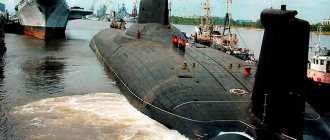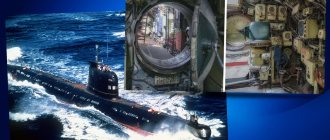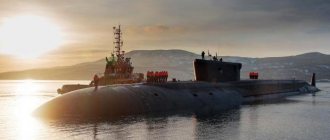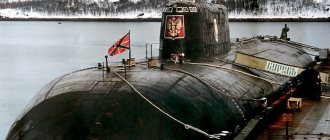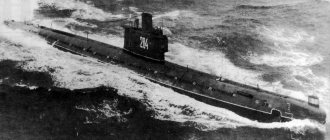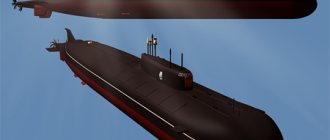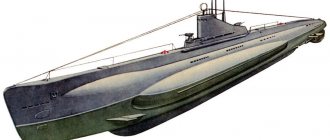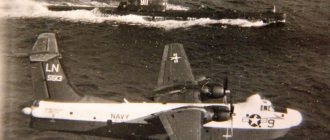The 19th century was marked by a number of science fiction predictions. One of these seemingly incredible projects was the Nautilus submarine, invented by the writer Jules Verne. By that time, there was only one all-metal submarine from which missiles were launched - the submarine of the Russian scientist Schilder. However, soon the technological progress of all countries was forced to produce similar ships in connection with the outbreak of hostilities. During the American Civil War, the first ship was sunk by a submarine. Already in the First World War, all leading countries had a submarine fleet. Submarines have been recognized as an effective weapon for warfare. Much has changed since then: submarines began to be produced in different sizes, from the smallest to the gigantic, with their own nuclear reactors on board. Submarines are used not only for military purposes, but also for peaceful purposes - as research bases.
10.Astyut (Estute)
Astute class submarines are operated by the British Navy. As of 2014, these submarines were the most advanced designed in England. By 2022, the construction of 3 such boats was completed, and 4 more are being prepared for launch. In 2012, testing of these submarines was completed successfully, and the Astyuts demonstrated their ability to effectively launch two Tomahawks simultaneously to successfully hit a target. The names of the submarines of this class are Estute, Embouche, Artful (currently operational), Odeisches, Anson, Agamemnon (laid down and awaiting completion) and Ajax (a production contract has been signed). The length of these boats reaches 97 m in length, immersion depth - 300 m, displacement - 7,800 tons. "Astyut" is equipped with 6 480 mm TA, missiles of the Tomahawk and Harpoon types and additional TA of 533 mm caliber.
9.Seawolf
Seawolf was the American response to the Soviet Shchuka-B cruisers during the Cold War. Initially, it was planned to build twelve such submarines, however, until 1998, only 3 were launched, after which the project lost its relevance. The length of the Seawolf hull is 107.6 m. The maximum diving depth is 600 m. The speed of boats of this class is 18 knots. Surface displacement is 10,500 tons, underwater displacement is 12,200 tons. The armament on these ships includes 8 660 mm TA, torpedoes and Tomahawk missiles.
8.Condor
The Condor is the first of the giant submarines in service with the Russian fleet. By 2022, our army will have two Condor cruisers in service, each of which is 110.5 m long. The Condor hull is made of titanium alloy, which is much lighter and stronger than standard metals, which allows the ship to dive to great depths, in compared to its predecessors, and do it much more unnoticed by enemy reconnaissance equipment. There are two representatives of this type of submarine: “Zubatka” and “Perch”. In the future, it is planned to modernize both ships at the Zvezdochka CS. This means a complete overhaul and debugging of submarine systems, as well as the installation of the latest navigation systems and the Caliber cruise missile system. The maximum diving depth of the Condor is 600 m. Submarines of this class can reach speeds of up to 35 knots under water. Displacement -10,400 tons. The Condor's armament consists of 6 TA 533 mm, torpedoes and Granat-type cruise missiles, as well as 8 man-portable anti-aircraft missile systems "Igla" and "Igla-1".
Design
The power plant is made in the form of two independent echelons located in different durable buildings. The reactors are equipped with an automatic shutdown system in case of loss of power supply and pulse equipment for monitoring the condition of the reactors. When designing, the TTZ included a clause on the need to ensure a safe radius; for this purpose, methods for calculating the dynamic strength of complex hull components (fastening modules, pop-up cameras and containers, inter-hull connections) were developed and tested by experiments in experimental compartments.
To build the Sharks, a new workshop No. 55 was specially built at Sevmash - the largest indoor boathouse in the world. The ships have a large reserve of buoyancy - more than 40%. When submerged, exactly half of the displacement is accounted for by ballast water, for which the boats received the unofficial name “water carrier” in the navy, and in the competing design bureau “Malachite” - “a victory of technology over common sense.” One of the reasons for this decision was the requirement for the developers to ensure the smallest draft of the ship to be able to use existing piers and repair bases. Also, it is the large reserve of buoyancy, coupled with a durable deckhouse, that allows the boat to break through ice up to 2.5 meters thick, which for the first time made it possible to conduct combat duty in high latitudes right up to the North Pole.
7.Pike-B
Despite the fact that “Pike-B” is somewhat inferior to “Condor” in length (111.7 m), it is somewhat “heavier”, having over 13 meters in width. Shchuka-B is a Soviet design, one of the largest nuclear submarines at the time of its release. Unlike the Condors assembled later, the Pike has a steel hull. Project 971 existed from 1983 to 2001, coming under the jurisdiction of the Russian Federation. During the period of its release, the project has undergone several revisions and changes. As a result of the modification, the “Pike” received the names “Nerpa”, “Cheetah” and others, and in the West they are called “Improved Akula”. By 2022, there will be 4 operational submarines of this class left. They are armed with 4 650 mm and 2 533 mm TAs, Kalibr-PL and Strela-ZM missile systems. The maximum diving depth of the “Pike” is 600 m, displacement is 12,700 tons.
Frame
One of the main features of the Shark 941 project is a multi-layer hull, distinguished by its unique strength. It contains 5 habitable chambers with a diameter of 10 m, placed parallel to each other. The bow accommodates missile silos, which were built for the first time forward of the deckhouse.
Next to it are 3 more compartments:
- Torpedo.
- Modular, on which the central post is located.
- Stern mechanical.
The layout of the internal compartments made it possible to reduce the fire hazard and increase the survivability of the ship.
According to designer Kovalev: “The accident that happened with the Kursk cannot be repeated on the Akula.” Even if a torpedo explodes inside the submarine, due to the fact that it is located inside a separate module, serious destruction of the bow and death of the entire crew will not occur.”
In total, the Shark has 19 waterproof and 2 rescue chambers designed to evacuate the entire crew. They are located under the base of the command post, next to the fence of the retractable device.
6. Triumphant
One of the few European countries armed with giant submarines is France. The Triumphant class submarines were built between 1989 and 2009. 4 of the planned 6 units were launched. The length of each is 138 meters. The maximum diving depth is more than 400 m. Equipment is four 533 mm torpedo tubes, 10 torpedoes, 8 Exocet SM39 cruise missiles. Displacement – 14,300 tons.
Habitability
The crew is accommodated in conditions of increased comfort. The boat has a lounge for relaxation, a gym, a swimming pool measuring 4x2 m and a depth of 2 m, filled with fresh or salt sea water with the possibility of heating, a solarium, a sauna lined with oak boards, and a “living corner”. The rank and file are accommodated in small cockpits, the command personnel are accommodated in two- and four-berth cabins with washbasins, televisions and air conditioning. There are two wardrooms: one for officers, the other for midshipmen and sailors. Sailors call the Shark a “floating Hilton.”
5. Vanguard
Four Vanguard-class submarines are in service with the British Navy. These are nuclear giants almost 150 meters long, the construction of which began in the nineties of the last century. The Vanguards are equipped with four 533 mm caliber TAs, sixteen Trident II D5 missiles and torpedoes. The maximum diving depth is 400 m. Correspondence between surface and underwater displacement is 15,100 and 15,900 tons.
Reserve means of propulsion
This indicator includes four units:
- A pair of diesel generators.
- Lead-acid battery.
- A couple of spare electric motors that have a power of 260 kW.
- A series of thrusters equipped with rotating propellers. They are necessary in order to maneuver in a clamped position. This package includes 750 kW electric motors. The devices were located in the bow and stern parts.
4.Delta
“Delta” is not a separate class, but a collective name for a series of nuclear submarines developed in the USSR. “Delta” included submarines of the “Squid”, “Dolphin”, “Murena” and “Murena-M” series. The most advanced modification of the Delta, the Dolphin, has a length of 167.4 m. 7 Dolphins were built, 5 of which are still in service with the Russian submarine fleet. "Delta" is equipped with 4 TA 533 mm, 12 torpedoes, 16 ballistic missiles and up to 8 anti-aircraft missile systems "Igla" and "Igla-1". The maximum diving depth is up to 650 meters. Surface displacement - 11,700 tons, underwater - 18,200 tons.
The fastest submarine in the world: K-222
Submarine "K-222"
The submarine of the Soviet Union "K-222", nicknamed "Golden Fish", is to this day the fastest cruiser.
The model reached and recorded more than 82 kilometers per hour in a submerged position, which by sea standards is about 44 knots. The K-222 was equipped with the P-70 Amethyst armed cruise missile.
The fastest submarine owes its appearance to Soviet designers N.N. Isanin and N.F. Shulzhenko, working with his colleagues in the city of Severodvinsk.
The goal of the project sounded clear and concise - to create an underwater vessel capable of delivering missile and torpedo strikes against aircraft carrier formations.
A distinctive feature of the submarine was the order to supply the K-222 only with new developments in instruments, automation and equipment.
Thus, the high-speed nuclear submarine became a unique exhibit in the history of the fleet.
The fastest submarine, K-222, made of a titanium hull, was intended to become the flagship of the submarine fleet. But her fate was sad.
In 1988, the high-speed submarine was withdrawn from the fleet, and later, in modern Russia, the government decided to dismantle it.
3.Ohio
Ohio is the largest submarine in service with the United States. Today they actively patrol the country's borders, spending up to 60% of their time underwater. At the same time, the submarines of this series are quite old - the first of them was launched in 1081. The length of the nuclear giant Ohio is 170.7 m. Due to its enormous size, the Ohio is capable of carrying more than 20 Trident II missiles and over 150 Tomahawk missiles. To launch projectiles, the Ohio is equipped with 4 TA 533 mm. Ohio's displacement is 18,800 tons.
When did the first submarines appear?
There is vague evidence of an extant 1190 epic, Salman and Morolf, in which the protagonist traveled underwater in a longship submarine with a tightly sealed waterproof leather deck. But the first reliable information about the continuation of man’s assault on the underwater world dates back to the beginning of the 16th century.
The mechanisms, the diagrams of which he found in the papal archives, may not have been implemented, but they gave flight to the creative thought of a genius. The first reliable drawing of a muscle-powered submarine belongs to the great Leonardo.
After him, the history of the development of human assault on the depths accelerates:
- 1538 ─ maritime superpower Spain tests an underwater bell under Emperor Charles V;
- 1620 (approximately) ─ mechanic Cornelius Drebbel with King James I conduct the first launch of a rowing submarine with a crew of 15 people;
- 1716 ─ space explorer Halley invents the supply of oxygen to a diving bell.
His invention was later improved by a pump system. The emergence of a relatively autonomous combat submarine seemed about to take place.
2.Borey
"Borey" is somewhat inferior to "Ohio" in the length of the hull (170 m), but is almost a meter wider, due to which it has a greater displacement. This is a Russian submarine, which is one of the most advanced designs in the world. By 2027, Russia plans to launch 14 ships of this type. It is planned that “Borey” will replace “Delta” and “Shark”, which will be discussed further. "Borey" can reach speeds of up to 29 knots. The Borey's displacement is 24,000 tons. The submarine's equipment is 6 TA 533 mm, 6 hydroacoustic countermeasures of 324 mm caliber, torpedoes, cruise missiles "Onyx" and "Caliber", as well as 16 launchers of the Bulava complex. "Borey" can truly be called deadly.
Power propulsion system
The movement of a multi-ton submarine occurs using a nuclear energy complex designed on a block principle.
It and a number of other units, connected by the designers into one whole, make the “Shark” mobile:
- Pressurized water reactor, capacity 190 MW – 2 pcs.
- Steam turbine system available in each building - 2 pcs.
- Two-stage installation – 1 pc.
- Seven-blade fixed-pitch propeller with installed ring fairings (fenestrons) – 2 pcs.
In addition, there are 2 reserve engines of 190 kW each, they can ensure continuous operation of the submarine in the event of a shutdown of the main units for several hours.
To carry out maneuvers in a closed space, there are 2 separately located 750 kW motors installed in a thruster mechanism with its own rotary propeller located on each side of the ship.
1.Project 941 “Shark”
The largest existing submarine is the domestic Akula, known in the West as the Typhoon. Sharks were developed during the Cold War to counter the American threat. The length of this steel nuclear predator is 172.8 m. Surface displacement is over 23,000 tons, underwater displacement is 48,000 tons. The strategic purpose of the project was a long-term “ambush” in the Arctic Circle, from where, according to the plan, ballistic missiles were to be launched at enemy targets. shores. "Sharks" were built for long-term autonomous navigation. The height of these ships is comparable to modern nine-story buildings. Inside each Project 941 cruiser there were five residential blocks, in which the crew had access to gyms, swimming pools and even a real bathhouse. The decor and furnishings of the premises were more like a luxury hotel than a military facility. Even the doorways in the underwater giants' quarters were full-size, unlike most other submarines. A total of six ships from the Project 941 series were built. Unfortunately, they did not last long - less than 10 years later they were decommissioned due to the high costs of their maintenance. At the moment, only one modified submarine from this series remains afloat - Dmitry Donskoy. It is used to test Bulava-type ballistic missiles.
Armament
The Akula submarine is equipped with primary and secondary weapons, which are designed to destroy enemy targets located in line of sight or at a distance of more than 8,000 km.
Basics
This submarine has a D-19 installation with ballistic missiles having a launch weight of 90 tons and a length of 17 m. The combat flight range is 8,300 km with a detachable part for 10 warheads of 100 kilotons each.
In the entire history of the use of such weapons, the Project 941 submarine and its subsequent modifications were its only carrier; there are no other analogues capable of taking on such an amount of explosive.
The launch of a full load of ammunition is carried out with a single shot or successive salvos, both on the surface and from a submerged state. The maximum diving depth at the start of the D-19 reaches 56 m, without restrictions on weather conditions.
In total, the Akula submarine has 20 units of such missiles on board, although initially Kovalev planned to install 24 units, but the Commander-in-Chief of the Navy S.G. Gorshkov decided to stop at 20.
Secondary
In addition to strategic weapons, the submarine missile carrier has on board a minefield installation system, 6 torpedo cycle devices with a 533mm barrel, used for fire support for missile torpedoes, 8 Igla 1 MANPADS and a whole range of electronic weapons:
- "Omnibus", a militarized information management complex.
- "Skat-KS", hydroacoustics system.
- "Harp MG-519", a hydroacoustic unit for searching for mines.
- "Sever MG-518", an echo sounder for measuring ice thickness.
- "BuranMRKP-58", radar device.
- "Symphony", navigation block.
- "Molniya L-1", a radio communication device equipped with the Tsunami satellite system.
- MTK-100, TV block.
- 2 antennas - buoys, which, when the boat is at a depth of more than 150 m, float up and receive radio signals and information from the satellite.
Began after the Great Patriotic War of 1941 - 1945. The cold war, which continued as a long arms race between the two world powers, ended thanks to the partial contribution of the Akula series submarines.
The impressive size of the ship and the huge arsenal on board, allowing it to launch a salvo of 20 missiles at any time anywhere in the world, contributed to the long-term confrontation and ended it with the signing of a peace agreement.
